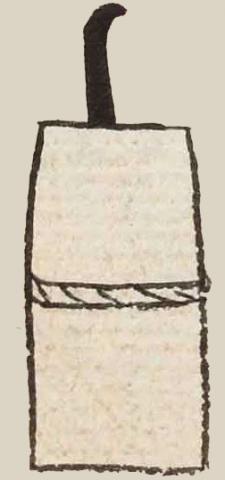Itzamatitlan (Mdz24v)
This black-line drawing for the compound glyph for the place name Itzamatitlan (Next to Obsidian-Paper) shows a frontal view of a vertical obsidian blade with a curve at the top (toward the reader's right). Below the black is a white, rolled piece of paper (amatl) with a cord around it. The -titlan locative suffix is not shown visually.
Stephanie Wood
Obsidian knives could have sacrificial uses, and they could have strong associations with divine forces such as the Obsidian Knife Butterfly, or hunting deities, or power, omnipotence, often malevolence, feasting, and revelry. They could also adorn capes and skirts, and they could be placed in a womb if a baby died in childbirth. (See the Online Nahuatl Dictionary for the citations to this information.)
Stephanie Wood
yzamatitlan. puo
Itzamatitlan, pueblo
Stephanie Wood
c. 1541, or by 1553 at the latest
Stephanie Wood
obsidian blades, flint knife, flint knives, papers, paper rool, nombres de lugares

itz(tli), obsidian blade, https://nahuatl.wired-humanities.org/content/itztli
ama(tl), paper, https://nahuatl.wired-humanities.org/content/amatl
-titlan (locative suffix), next to, in, between, below, with, in the company of, https://nahuatl.wired-humanities.org/content/titlan
Codex Mendoza, folio 24 recto, https://digital.bodleian.ox.ac.uk/objects/2fea788e-2aa2-4f08-b6d9-648c00..., image 59 of 188.
The Bodleian Libraries, University of Oxford, hold the original manuscript, the MS. Arch. Selden. A. 1. This image is published here under the UK Creative Commons, “Attribution-NonCommercial-ShareAlike 3.0 License” (CC-BY-NC-SA 3.0).




